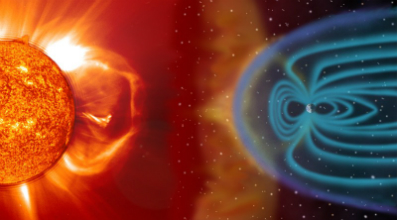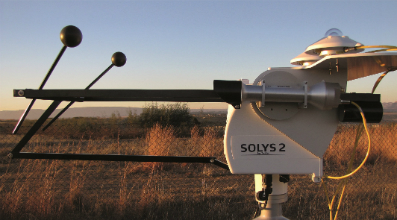The term solar monitoring is most commonly used to refer to procedures for the on-going measurement of solar radiation using dedicated instruments and related activities, such as the capture and processing of measured data, often for the purpose of validating the operation of PhotoVoltaic (PV), Concentrating PhotoVoltaic (CPV) or thermal Concentrating Solar Power (CSP) plants, as well as the monitoring of solar activity.
Due to the various interpretations, the term can make it difficult even for experts to understand what is actually meant. Activities and measurement procedures described by the term solar monitoring include, for example:
Solar activity monitoring – measurements related to activity of the sun itself; amongst them solar winds and flares, and magnetic activity, that impact upon satellite operations and the Earth’s atmosphere.
Solar radiation monitoring – solar radiation measurements at, or close to, the Earth’s surface in the wavelength range from 280 nanometers (10-9 m)) in the ultraviolet to 4000 nm in the near infrared region. This comprises Direct Normal Irradiance (DNI) from the sun and Diffuse Horizontal Irradiance (DHI) from the sky.
Solar photovoltaic system monitoring – measurements for monitoring and control of photovoltaic systems, such as solar radiation measurements, PV system data logging, solar yield and efficiency analysis. This is typically the Global Horizontal Irradiance (GHI) and tilted, plane of array, irradiance.
Solar concentrating photovoltaic system monitoring – solar radiation measurements and data logging of DNI for CPV focusing systems using lenses.
Solar thermal concentrating power system monitoring – measurements and data logging of DNI for CSP systems using reflectors, troughs or mirrors to concentrate radiation onto a heat transfer fluid system to power steam turbine generators.
Solar activity monitoring
The term covers a number of monitoring and measurement activities, such as the monitoring of magnetic activity, sunspots and flares. The term space weather describes the effects of solar activity, such as Coronal Mass Ejections (CMEs) and the solar wind, a stream of ionised particles, mostly comprising electrons and protons that flows from the sun at great speed and partially reaches the earth.
 CMEs are violent eruptions of plasma at the sun’s surface whose streams can reach heights of 100,000 km or more. If the ejections are strong enough they can cause changes in the Earth’s geomagnetic field that result in geomagnetic storms, which can cause transformers to become saturated, transmission networks to malfunction and disrupt the supply of electricity. In extreme cases they can severely damage the electrical network, affect pipelines and disrupt telecommunications (particularly satellites), resulting in great economic damage.
CMEs are violent eruptions of plasma at the sun’s surface whose streams can reach heights of 100,000 km or more. If the ejections are strong enough they can cause changes in the Earth’s geomagnetic field that result in geomagnetic storms, which can cause transformers to become saturated, transmission networks to malfunction and disrupt the supply of electricity. In extreme cases they can severely damage the electrical network, affect pipelines and disrupt telecommunications (particularly satellites), resulting in great economic damage.
Ionised particles in the solar wind cause the polar lights, known in the northern hemisphere as the Aurora Borealis. The name is most commonly believed to have been coined by Galileo; after Aurora, the Roman goddess of dawn, and Boreas, the Greek god of the north wind. The corresponding southern effect is the Aurora Australis.
Solar radiation monitoring
The first person known to have hypothesised a link between solar radiation and the Earth’s climate was astronomer William Herschel in the early 19th century. Ground-based solar radiation measurements are performed for different purposes in the fields of meteorology, climatology, agronomy and health care as well as for the purpose of monitoring photovoltaic or thermal solar power plants.
Whereas wavelengths within the visible spectrum are mostly measured for purposes in relation to electricity production and illumination, other wavelengths are also important for agronomic and climatological purposes, particularly infrared thermal radiation. UV radiation is regularly monitored due to its harmful effects on human health and the biosphere in general. Other parameters are also measured, such as the spectral density of solar radiation, which tells us how the power of solar radiation changes with wavelength and is very important in the exploitation of solar energy in practice, especially in the development of photovoltaic cells and materials for mirrors.
Direct Normal Irradiance (DNI) is the narrow beam of radiation received directly from the sun and is particularly important for systems with concentrators. It is measured using a Pyrheliometer, with a 5° field of view, mounted on an automatic sun tracker to point the instrument accurately at the centre of the sun. Global Horizontal Irradiance (GHI) is measured using a Pyranometer, which can be shaded from the direct beam of the sun to measure Diffuse Horizontal Irradiance (DHI) from the sky. A downwards-facing pyranometer can be used to measure the solar radiation reflected by the surface and enable the Albedo of the surface to be calculated.
Pyrgeometers, which are mainly used in climatological research, measure far infrared thermal radiation from the atmosphere (or the Earth’s surface) in the wavelength range from 4 µm (4000 nm) to beyond 40 µm. Combinations of different measurement instruments are often used at measurement sites, depending on the requirements or the purpose of the measurements, such as the Kipp & Zonen CMA Albedometers and CNR 4 Net Radiometer. Specially designed instruments are used in agronomy, for UV radiation measurement and sunshine duration.
In addition to measurement instruments, we also need various tools and accessories, such as solar trackers guided by a computer algorithm that calculates the exact position of the sun in real time and points the tracker, and the instruments that it carries, in the correct direction. Shading balls fitted to the tracker, as shown in the picture, are used to shade the detector surface of a pyranometer or pyrgeometer from the direct solar radiation so that it only measures the Diffuse Horizontal Irradiance (DHI).
 For all technologies of solar power generation, reliable and precise solar monitoring is a must. Thermopile type pyrheliometers and pyranometers measure all the solar radiation available, independent of the type of power conversion technology.
For all technologies of solar power generation, reliable and precise solar monitoring is a must. Thermopile type pyrheliometers and pyranometers measure all the solar radiation available, independent of the type of power conversion technology.
Solar photovoltaic system monitoring
The term solar monitoring is also often used to describe the monitoring of photovoltaic systems, which encompasses the measurement of incoming solar radiation for the purpose of monitoring the operation of a power plant and its electricity production. In order to avoid misunderstandings or errors, it is recommended in such cases to use the term solar photovoltaic system monitoring or solar PV monitoring. This type of monitoring system typically also includes instruments to measure other environmental parameters, such as temperature and wind.
The measurement data is recorded and stored locally and can be processed for the purpose of monitoring power plant operation, particularly the recovery, efficiency or estimated yield of the power plant, which is measured using performance ratio parameters. The data and derived products can be monitored both locally and remotely, through Internet access via computers or smart ‘phones.
Solar concentrating photovoltaic system monitoring
Photovoltaic systems with concentrators are suitable for areas with a high incidence of clear skies, and consequently high levels of direct solar radiation. Concentrating PV modules differ from regular flat panels in that they are fitted with lenses that concentrate the radiation by a factor of 100 times, resulting in much higher efficiency.
CPV cells are specially designed multi-layer, multi-junction types in which each p-n junction is sensitive to a certain wavelength of solar radiation. Checking CPV systems requires the accurate measurement of direct solar radiation using pyrheliometers mounted on a precise sun tracker. The concentrator modules also require accurate tracking, as incoming solar radiation can only be converted into electricity as efficiently as possible when exactly pointed at the sun.
Solar thermal concentrating power system monitoring
The term solar monitoring can also refer to monitoring the operation of thermal concentrating solar power plants with parabolic troughs, or mirrors, on trackers. Similarly to CPV systems, CSP plants require very accurate measurements of incoming direct solar radiation.
Though the term solar monitoring seems self-explanatory at first glance, it is obvious that care has to be exercised when using it. The term must be used with particular care in the field of solar energy, often with additional explanations as shown above, in order to avoid semantic and technical confusion.
Author
Denis Lenardic - holds a degree in electrical engineering from the University of Ljubljana, Slovenia. He is a member of Slovene national section of IEC TC82 Technical Committee where he served as chairman from 2004 till 2008. Professionally he is involved with semiconductor manufacturing.
Sources and recommended literature
World Meteorological Organisation. Guide to Meteorological Instruments and Methods of Observation. WMO-No. 8, 2008 Edition, Updated in 2010, http://www.wmo.int/
McArthur, Bruce, L.J. 2005. Baseline Surface Radiation Network. World Climate Research Programme. Operations Manual, Version 2.1. WCRP-121, WMO/TD-No. 1274.
Rösemann, R. 2011. A Guide to Solar radiation Measurement. Gengenbach Messtechnik.
Vignola, F. et al. 2012. Solar and Infrared Radiation Measurements. CRC Press.
Kipp & Zonen, Solar Monitoring Stations, Technical documentation, http://www.kippzonen.com/
Solar & Heliospheric Observatory, SOHO, http://sohowww.nascom.nasa.gov/
Merriam-Webster, online dictionary, www.merriam-webster.com